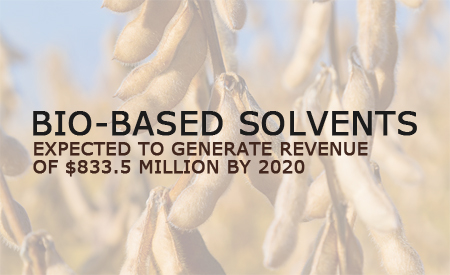Industry News, Agriculture & Feed
North America Dominates Oilfield Biocides Market

Industry News, Agriculture & Feed

Solvents have traditionally been derived from petroleum. These petroleum-based solvents are now being replaced by bio-based solvents, derived from renewable feedstocks such as corn, soybeans and orange peels. Bio-based solvents emit few to no volatile organic compounds (VOCs), which are harmful to human health and the ozone layer. In addition, bio-based solvents are less toxic and have less environmental impact; hence, they can be considered substitutes for traditional solvents.
In the oilfield industry, bio-based solvents have applications in drilling, production, completion fluids, fracturing, packer fluids, and more. The major types of bio-based solvents are hydrocarbons, alcohols, glycols, ketones, esters and ethers. Solvents also act as dissolving solids, heat management, enhance mixing, etc.
The global hydrocarbons market occupied a major share of 68% in 2014, and is estimated to grow at compound annual growth rate (CAGR) of 3.9% during 2015-2020 to reach $117.6 million by 2020. Alcohols are the organic compound with hydroxyl groups (-OH) bound to the carbon atoms of an alkyl group. Alcohols are one of the safer classes among solvents. Common solvents used in alcohols are ethyl alcohol, isopropyl alcohol, methyl alcohol, n-propyl alcohol, isoamyl alcohol and n-butyl alcohol. Alcohols have a share of 7.8% in global bio-based solvents in 2014, and are expected to grow at a CAGR of 5.3% during the forecast period.
Synthetic solvents have traditionally been the solvents used in oilfield and in other main applications. Synthetic materials used to prepare biocides and solvents result in harming the health of the humans and the environment. Disinfectants, insect repellents, industrial chemicals like anti-fouling paints for ships and materials, etc., are called biocides because they exhibit intrinsic properties that are harmful to living beings when exposed to them. Natural biocides can be derived from plants and bacteria, and have less of an environmental impact, with no or less VOCs. These solvents are derived from fruits, seeds and other natural materials. Esters held a market size of $10 million in 2014; they are estimated to reach $13.4 million by 2020 with a CAGR of 5.1% during the forecast period.
The European Chemicals Agency (ECHA) and European Solvents Industry Group are among the regulatory bodies that approve less-harmful biocides and bio-based solvents so that they have less impact on the environment. The rules and regulations are mandatory for the manufacturers of these products. In addition, the cost of production of bio-solvents is higher when compared to synthetic solvents. Hence, the high cost of production of bio-based solvents is a restraining factor for the oilfield bio-based solvents market. With the ongoing R&D activities relating to the production of common organic solvents from biological feedstock, there is a chance to produce bio-based solvents at lower cost.
Copyright of this article by ASI. We are sharing and promoting the market innovation.
If you like this article, kindly to visit www.adhesivesmag.com